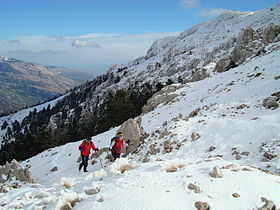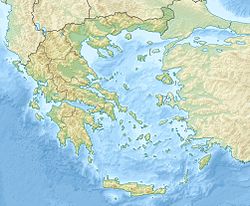- Mount Helicon
-
Mount Helicon Elevation 1,749 m (5,738 ft) Location Boeotia, Greece Range Helicon Coordinates 38°21′10″N 22°49′21″E / 38.35278°N 22.8225°ECoordinates: 38°21′10″N 22°49′21″E / 38.35278°N 22.8225°E Mount Helicon (Ancient Greek: Ἑλικών) is a mountain in the region of Thespiai in Boeotia, Greece,[1] celebrated in Greek mythology. With an elevation of 1,749 metres (5,738 ft), it is located just off the Gulf of Corinth.
Contents
Greek mythology
In Greek mythology, the mountain was celebrated by Hesiod because two springs sacred to the Muses were located here: the Aganippe and the Hippocrene, both of which bear "horse" (ἵππος hippos) in their toponym. In a related myth, the Hippocrene spring was created when the winged horse Pegasus aimed his hoof at a rock, striking it with such force that the spring burst from the spot. On Helicon too was the spring where Narcissus was inspired by his own beauty.[2]
In Greek myth, Helicon was sacred especially to the divinely inspiring Muses; in his Aitia, Callimachus recounts his dream in which he was young once more and conversed with the Muses on Helicon.[3] There had been a temple built on Helicon in their honor which contained statues of these Muses.[4]
The Hippocrene spring was considered to be a source of poetic inspiration. In the late seventh century BCE, the poet Hesiod sang how in his youth he had pastured his sheep on the slopes of Helicon[5] where Eros and the Muses already had sanctuaries and a dancing-ground near the summit, where "their pounding feet awaken desire".[6] There the Muses inspired him and he began to sing of the origins of the gods. Thus Helicon became an emblem of poetical inspiration.[7] Callimachus explicitly follows in the footsteps of Hesiod and he placed on Helicon the episode in which Tiresias stumbles upon Athena bathing and is blinded but given the art of prophecy.[8]
In Hesiod's Theogony Helicon was mentioned:
- "From the Heliconian Muses let us begin to sing,
- Who hold the great and holy mount of Helicon,
- And dance on soft feet about the deep-blue spring
- And the altar of the almighty son of Cronos, and,
- When they have washed their tender bodies in Permessus
- Or in the Horse's Spring or Olmeius,
- Make their fair, lovely dances upon highest Helicon
- And move with vigorous feet" [9]
In the Homeric Hymn to Poseidon, a brief invocation, the god is hailed as "Lord of Helicon".[10]
The cult centers on Helicon established in the Valley of the Muses, a fertile valley near Thespiai[11] and Ascra, under the influence of the Hesiodic texts, in Hellenistic times if not before, were visited by Pausanias in the second century CE.[12] He explored the sacred grove by the spring Aganippe thoroughly and left a full description as it then was. He saw images of Eupheme, nurse of the Muses, and of the legendary poet Linus "in a small rock which has been worked into the manner of a cave".[13] In the temenos were statues, some by famous masters, of Apollo and Dionysus and famed poets. The absence of Homer at Helicon has been noticed by Richard Hunter (Hunter 2006:18f): "The presence of Homer would spoil the party, for the tendency to see these as rival figures for supremacy in epos is familiar from the Contest of Homer and Hesiod, parts of which derive from the classical period". The sacrificial tripod which Hesiod won at a contest in Chalcis in Euboea was still on view at Helicon in Pausanias' day: the presence of Homer at the festival Hesiod mentions in Works and Days (650-59) was a later interpolation.
Since the Renaissance
The poetical image of Helicon established by the Roman poets became once more an emblem of cultural inspiration with the Renaissance and is often referred to in poetry.[14] Helicon was the inspiration for the balls held by the Hungarian composer Leó Festetics at his castle near Keszthely. Festetics also named the library he founded Helikon Library, promoting literacy and culture in his home city.
Modern references
During the 1980s an Australian Broadcasting Corporation radio arts programme was called Radio Helicon.[15]
References
- ^ Kerenyi, 1951:172.
- ^ Michael Grant and John Hazel. Who's Who in Classical Mythology. Oxford University Press, USA; reprinted 1993.
- ^ Callimachus, Aitia, noted by Richard Hunter, The Shadow of Callimachus: Studies in the Reception of Hellenistic Poetry at Rome 2006:16.
- ^ Grimal, Pierre. The Dictionary of Classical Mythology. Blackwell Publishing Limited, 1996.
- ^ Hesiod, Theogony, 23.
- ^ Hesiod, op. cit. 8.
- ^ Hesiod does mention other springs that were the haunt of the Muses: "They bathe their lithe bodies in the water of Permessos or of Hippocrene or of god-haunted Olmeios".
- ^ The connection between prophecy and poetry is noted by Hunter 2006:17 in recalling this connection of Callimachus and Helicon.
- ^ Hesiod, with commentary by Richard S. Caldwell. Hesiod's Theogony 1 - 8 Focus Publishing/R. Pullins Company 1987
- ^ Kerenyi, Karl, The Gods of the Greeks 1951
- ^ Hence "thespian".
- ^ Pausanias, Description of Greece, ix.29.5 and following sections.
- ^ Compare religious grottoes.
- ^ It was such a familiar touch that a humorous reference to Helicon is made in Gilbert and Sullivan's Princess Ida, near the beginning of Act II.
- ^ 75th Anniversary of ABC Radio ABC Website
Sources
- Richard Hunter, The Shadow of Callimachus: Studies in the Reception of Hellenistic Poetry at Rome (Cambridge University Press) 2006:16ff "De Monte Sororum: In the Grove".
Categories:- Mountains of Greece
- World Heritage Sites in Greece
- Geography of ancient Boeotia
Wikimedia Foundation. 2010.


